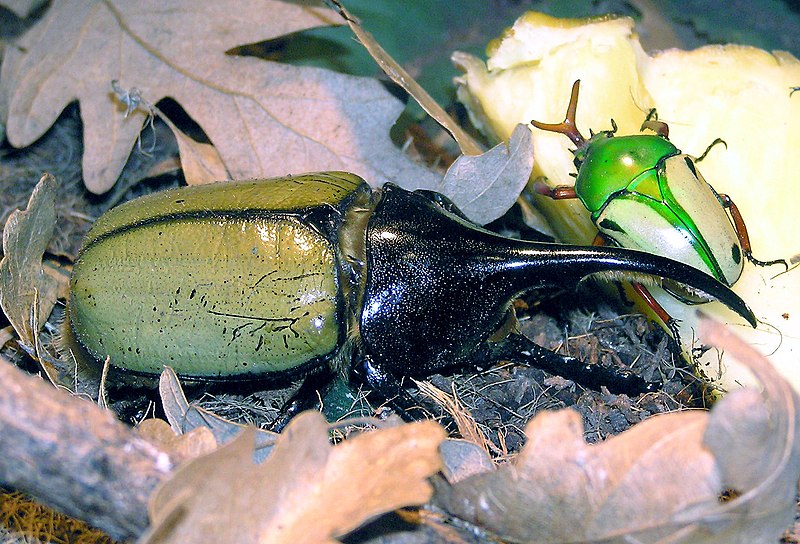Tarantulas and scorpions have long been invertebrate pet staples, with over 150 species being captive bred in large numbers. However, insect keeping, always popular in Japan but much less so elsewhere, is now coming into its own in the USA. I recently found that over 50 stick and leaf insect, 30 mantid, 25 cockroach and 25 beetle species, along with numerous grasshoppers, katydids, butterflies and moths, are now regularly bred in captivity.
Velvet Ants, Tarantula Wasps, Giant Water Bugs and innumerable others are also kept in smaller numbers, and are growing in popularity. An aquatic insect exhibit I recently designed for the Brooklyn Children’s Museum, featuring the usually ignored Water Scorpions and Whirligig, diving and water scavenger beetles, is a big hit with visitors.
Grand Possibilities
The potential diversity of insects that may be kept in captivity is limitless, and many exhibit their entire life cycles and full range of behaviors in a relatively limited space and time span. Those who keep insects are offered the real possibility of discovering new information.
behaviors in a relatively limited space and time span. Those who keep insects are offered the real possibility of discovering new information.
Conservation Value
Much of what has been learned by those keeping insects in private and public collections has conservation value. Captive breeding and reintroduction programs for endangered species ranging from Sphinx Moths in Arizona to Burying Beetles in Rhode Island have yielded promising results.
Other Invertebrates
An astonishing array of other terrestrial invertebrates are also being kept and bred in captivity, including Banana Slugs, trapdoor, orb-weaver, wolf and crab spiders, centipedes, millipedes, Vinegaroons and Sun Scorpions, to name just a few.
Further Reading
Japan’s Tama Zoo boasts 2 giant insect houses…be forewarned, insect aficionados who visit will emerge in shock, as did I!
Phasmids (walking sticks and walking leaves) have long been popular as captives in Europe. Photos of many of the nearly 3,000 described species, along with natural history notes, are posted here.
Founded in 1892, and with roots dating to 1872, the NY Entomological Society is an invaluable resource for insect enthusiasts. To learn more about this well-respected group and its publications, please visit their website.
 Snakes have a well-deserved reputation as escape artists and, once at liberty, they are nearly impossible to find. Almost always, the escapee shows up by accident, no matter how hard one searches – even quite large snakes can virtually disappear in relatively small areas (please see photo – the 16 foot long anaconda pictured there “vanished” in about 6 inches of water on the Venezuelan llanos; I took over an hour to find her despite “knowing” where she was!). However, there are a few tricks that can improve your chances of recapturing a lost pet…but first, if I may, a few related stories:
Snakes have a well-deserved reputation as escape artists and, once at liberty, they are nearly impossible to find. Almost always, the escapee shows up by accident, no matter how hard one searches – even quite large snakes can virtually disappear in relatively small areas (please see photo – the 16 foot long anaconda pictured there “vanished” in about 6 inches of water on the Venezuelan llanos; I took over an hour to find her despite “knowing” where she was!). However, there are a few tricks that can improve your chances of recapturing a lost pet…but first, if I may, a few related stories: That Reptile Blog – Reptile, Amphibian and Exotic Pet Care and Information
That Reptile Blog – Reptile, Amphibian and Exotic Pet Care and Information

 It was to be over 15 years before I next crossed paths with the Huntsman Spider – this time in a Bronx Zoo building (JungleWorld) in which I worked as an animal keeper. A huge population, having arrived with tropical plants, was established, and I was ecstatic (my mammal-keeping co-workers were far less impressed!).
It was to be over 15 years before I next crossed paths with the Huntsman Spider – this time in a Bronx Zoo building (JungleWorld) in which I worked as an animal keeper. A huge population, having arrived with tropical plants, was established, and I was ecstatic (my mammal-keeping co-workers were far less impressed!). Bog Turtles (Clemmys muhlenbergi) and other retiring, shallow water species are usually most comfortable in heavily planted terrariums, with plenty of dead wood and moss available for hiding (please see photo). These will readily utilize artificial plants as well.
Bog Turtles (Clemmys muhlenbergi) and other retiring, shallow water species are usually most comfortable in heavily planted terrariums, with plenty of dead wood and moss available for hiding (please see photo). These will readily utilize artificial plants as well. You can also create your own shelters…broken clay flower pots are an old standby. The Common Musk Turtle (Sternotherus odoratus) pictured here has been with me for 40 years. It is posing before its very unique cave – a 100 year old tile from the roof of the Bronx Zoo’s Reptile House!
You can also create your own shelters…broken clay flower pots are an old standby. The Common Musk Turtle (Sternotherus odoratus) pictured here has been with me for 40 years. It is posing before its very unique cave – a 100 year old tile from the roof of the Bronx Zoo’s Reptile House! behaviors in a relatively limited space and time span. Those who keep insects are offered the real possibility of discovering new information.
behaviors in a relatively limited space and time span. Those who keep insects are offered the real possibility of discovering new information.